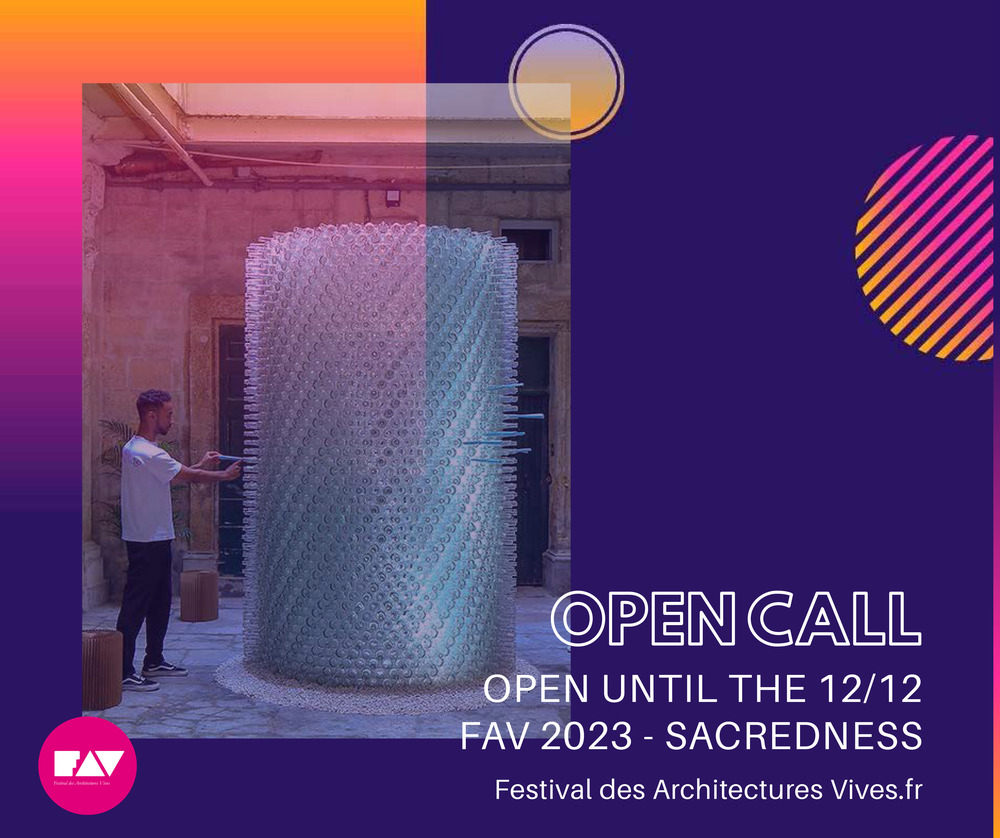19 Oct 2022

On the occasion of the 17th Festival des Architectures Vives, the Champ Libre association is launching an open call to create 1 of 10 interventions of the Festival.
The Festival takes place in the heart of the city of Montpellier, taking place in the Ecusson and, more specifically, in the courtyards of certain mansions, thus offering a sort of route of architectural discovery to visitors.

The dual objective of FAV Montpellier is to, on one hand, open these emblematic places to visitors during the festival. On the other hand, thanks to the intervention of teams of architects, a specific work will be presented at each location, revealing the intimate relationship between contemporary architecture, an installation, and a heritage site.
Theme: Sacredness
Today, the notion of sacredness takes on many forms. We are experiencing a shift in sacred perceptions in contemporary society, from the religious – with its very codified spaces and rites – to the sporting, the cultural, the secular, and the political. Sport has taken on the status of a new religion for some, and large stadiums have thus become high places of the collective rite with unifying times that mark history.
At the same time, major sports facilities are iconic places of architecture, and showcases of this "magnified" sacredness, such as the "Nest" of Herzog and de Meuron for the Beijing stadium. The school has lost its stage, just as the status of teaching has changed. The space tells us about this paradigm shift from which new programs flow, sanctuarized by architecture and emblematic of a society that adopts other benchmarks. Therefore, it is difficult to define what is sacred or what is not with great certainty. The environmental awareness and climate emergency that have been imposed on us have a definite influence on the implementation of this new paradigm.
However, if the apprehension of the sacred presents a great complexity and diversity of approach, the association of sacred/space is an obvious fact which makes it possible to approach it more clearly. As soon as the space makes the expression of sacredness felt, it is no longer really useful to decipher it. Talking about it is too complex, even taboo. The sacredness in space is not told...it is experienced.
In this displacement of values, each new sacredness has its rites and rituals that undeniably mark the space. Like contemporary society, the relationship between time and communication plays a transformed role. The rite is composed of three aspects described by Lévi Strauss: the “uttered words”, the “performed gestures” and the “manipulated objects” are upset by these mutations. Although these three types of actions are also present in secular life, they are performed in a specific way for the rite, which is revealed only in a given place.
Even moving, the space of the sacred takes on universal features by staging the forbidden, the preserved, the closed, the initiatory, and the mysterious, in a strong relationship with its context. It is the place that produces the first feeling of the sacred. It accompanies the attitude of the body, and brings the conditions of calm or intensity, sharing or introspection. The courtyards of mansions, protected, secret, and introverted places, invite this reflection on sacredness. They constitute a privileged framework for questioning the place and the condition of the sacred in the dense city, and more particularly in a historical fabric. This approach can re-examine urban imaginations, and summon myths, icons, memories, or even fetishism in their sacred dimension.
Annabelle ISZATT
Architect, teacher-researcher
Method of selection
The consultation is open to young architects and landscape architects. The aim is to promote young architectural creation. It is possible to form a multidisciplinary team, but it must comprise at least one architect.
Applicants must use this form, and applications must be sent as a single PDF file not exceeding 10MB. Failure to adhere to those requirements will result in a rejection of the application.
Application file
The application file must consist of the following documents:
+ Presentation of the team to download and send back, to its members, with the Curriculum Vitae of each member. (Required) - 1 A4 format per team member.
+ Illustrated references of your architectural achievements, installations, competition, etc. (mandatory)
+ Note of intent about the theme of the Festival des Architectures Vives. This note of approximately one page must express how the candidate envisions their installation and must be accompanied by an image (mandatory)
Candidates should note that these are original creations that must be presented within the framework of the FAV. Therefore, it is essential to cite and reference all sources for your projects.
Selection results will be announced in January 2023.
A detailed file presenting the technical constraints related to the design of an intervention (ground, exhibition, photos, survey, etc.) will be delivered to selected candidates. The selection of teams will be made exclusively from this file.
Deadline for submitting applications
Applications must be received by no later than midnight on Monday, December 12, 2022, France time (GMT + 1 / date of deposit being authentic).
For the ten selected teams
The Festival will take place from June 13 to 18, 2023. The installation and dismantling of the installations must be carried out on-site by the team itself, from June 8 to 12, 2023, and dismantling is scheduled for June 19, 2022.
It will be possible to visit the sites during an organized visit in January 2023.
A subsidy of € 1,500.00, including tax, will be allocated to each of the 10 projects carried out.
The book the 17th edition presenting the achievements will be published at the end of 2023.
Specific constraints: some installations will take place in the courtyards of private hotels, therefore occupancy considerations must be taken into consideration so as not to harm either the inhabitants or the built environment. The safety of visitors and residents must be ensured at all times, day and night.
